Fort Worth, Texas, Hgh State Clinic, Hgh Injections, Hrt Doctors
Fort Worth, Texas Blood Testing Facilities
 Represents a LabCorp blood testing facility
Represents a LabCorp blood testing facility Represents a Quest Diagnostics blood testing facility
Represents a Quest Diagnostics blood testing facility

Nearby Labcorp Blood Testing facilities:
- Labcorp Center Distance: 0 m, 1106 Alston Ave Suite 250, Fort Worth, Tarrant County, TX, 76104
- Labcorp Center Distance: 7 m, 6210 John Ryan Dr Ste 110, Fort Worth, Tarrant County, TX, 76132
- Labcorp Center Distance: 8 m, 4504 Boat Club Rd Ste 300, Fort Worth, Tarrant County, TX, 76135
- Labcorp Center Distance: 9 m, 4351 Booth Calloway Suite 105, North Richland Hills, Tarrant County, TX, 76180
- Labcorp Center Distance: 12 m, 515 W Mayfield Rd Ste 401, Arlington, Tarrant County, TX, 76014
- Labcorp Center Distance: 13 m, 350 Westpark Way Ste 104, Euless, Tarrant County, TX, 76040
- Labcorp Center Distance: 14 m, 2020 E Randol Mill Rd Ste 302, Arlington, Tarrant County, TX, 76011
- Labcorp Center Distance: 15 m, 300 N. Rufe Snow Ste 101, Keller, Tarrant County, TX, 76248
- Labcorp Center Distance: 17 m, 328 W Main St Ste 9, Azle, Other, TX, 76020
- Labcorp Center Distance: 19 m, 1600 W.College St Ste Ll30, Grapevine, Tarrant County, TX, 76051
- Labcorp Center Distance: 22 m, 1302 Lane St Ste 800, Irving, Dallas County, TX, 75061
- Labcorp Center Distance: 24 m, 7501 Las Colinas Blvd Ste 100, Irving, Dallas County, TX, 75063
- Labcorp Center Distance: 26 m, 951 York Dr Ste 101, Desoto, Dallas County, TX, 75115
- Labcorp Center Distance: 27 m, 750 Eureka St Ste C, Weatherford, Parker County, TX, 76086
- Labcorp Center Distance: 28 m, 203 Walls Dr Ste 102, Cleburne, Johnson County, TX, 76031
- Labcorp Center Distance: 29 m, 1411 N.Beckley Ste161 Paviii, Dallas, Dallas County, TX, 75203
- Labcorp Center Distance: 31 m, 4144 N. Central Expwy Ste 740, Dallas, Dallas County, TX, 75204
- Labcorp Center Distance: 32 m, 4323 N Josey Lane Suite 200B, Carrollton, Denton County, TX, 75010
- Labcorp Center Distance: 33 m, 6301 Gaston Avenue 405-W, Dallas, Dallas County, TX, 75214
- Labcorp Center Distance: 34 m, 1205 Medical Plaza Ct, Granbury, Hood County, TX, 76048
- Labcorp Center Distance: 36 m, 5944 W Parker Rd Ste 200, Plano, Collin County, TX, 75093
- Labcorp Center Distance: 37 m, 2000 S Fm 51, Decatur, Wise County, TX, 76234
- Labcorp Center Distance: 38 m, 399 W. Campbell Rd Ste 210, Richardson, Dallas County, TX, 75080
- Labcorp Center Distance: 39 m, 3880 Parkwood Bvd Bldg3 Ste302, Frisco, Collin County, TX, 75034
- Labcorp Center Distance: 40 m, 5308 N Galloway 202, Mesquite, Dallas County, TX, 75150
- Labcorp Center Distance: 42 m, 2821 E President George Bush Hwy Ste 302, Richardson, Collin County, TX, 75082
- Labcorp Center Distance: 43 m, 341 Wheatfield Dr Ste 130, Sunnyvale, Dallas County, TX, 75182
- Labcorp Center Distance: 46 m, 1111 Raintree Cir Ste 250, Allen, Collin County, TX, 75013
- Labcorp Center Distance: 47 m, 7801 Lakeview Parkway 110, Rowlett, Dallas County, TX, 75089
- Labcorp Center Distance: 48 m, 400 Sw 25Th Ave, Mineral Wells, Palo Pinto County, TX, 76067
- Labcorp Center Distance: 49 m, 4201 Medical Center Dr Ste 390, Mckinney, Collin County, TX, 75069
- Labcorp Center Distance: 52 m, 1871 Harroun Ave Ste 300, Mckinney, Collin County, TX, 75069
- Labcorp Center Distance: 58 m, 874 Ed Hall Dr. 114, Kaufman, Kaufman County, TX, 75142
- Labcorp Center Distance: 62 m, 411 N Belknap St, Stephenville, Erath County, TX, 76401
- Labcorp Center Distance: 74 m, 300 N. Highland 130, Sherman, Grayson County, TX, 75092
- Labcorp Center Distance: 75 m, 3101 Joe Ramsey Blvd E Ste 105, Greenville, Hunt County, TX, 75401
- Labcorp Center Distance: 76 m, 2001 N Loy Lake Rd Ste M, Sherman, Grayson County, TX, 75090
- Labcorp Center Distance: 85 m, 2410 Wycon Drive Suite 104, Waco, McLennan County, TX, 76712
Nearby Quest Blood Testing facilities:
- Quest Center Distance: 1 m, 1250 8Th Avenue, Fort Worth, Tarrant County, TX, 76104-4156
- Quest Center Distance: 6 m, 5500 Overton Ridge Blvd, Fort Worth, Tarrant County, TX, 76132-3281
- Quest Center Distance: 8 m, 4625 Boat Club Rd, Lake Worth, Tarrant County, TX, 76135-7022
- Quest Center Distance: 10 m, 7630 N Beach St, Fort Worth, Tarrant County, TX, 76137-3017
- Quest Center Distance: 11 m, 1001 W Arbrook Blvd, Arlington, Tarrant County, TX, 76015-4222
- Quest Center Distance: 13 m, 3529 Heritage Trace Parkway, Keller, Tarrant County, TX, 76244-0970
- Quest Center Distance: 14 m, 990 Highway 287 N, Mansfield, Tarrant County, TX, 76063-2611
- Quest Center Distance: 17 m, 124 Industrial Ave, Azle, Parker County, TX, 76020-2934
- Quest Center Distance: 22 m, 3501 N Macarthur Blvd, Irving, Dallas County, TX, 75062-3636
- Quest Center Distance: 26 m, 1105 Sante Fe, Weatherford, Parker County, TX, 76086-5852
- Quest Center Distance: 31 m, 3900 Junius St, Dallas, Dallas County, TX, 75246-1615
- Quest Center Distance: 32 m, 4333 North Josey Lane Plaza Ii, Carrollton, Denton County, TX, 75010-1601
- Quest Center Distance: 33 m, 805 Hill Blvd, Granbury, Hood County, TX, 76048-1482
- Quest Center Distance: 34 m, 11613 N Central Expwy, Dallas, Dallas County, TX, 75243-3843
- Quest Center Distance: 36 m, 1151 N Buckner Blvd, Dallas, Dallas County, TX, 75218-3400
- Quest Center Distance: 38 m, 3801 W 15Th St Ste 100, Plano, Collin County, TX, 75075-7752
- Quest Center Distance: 39 m, 3230 I- 30 East, Mesquite, Dallas County, TX, 75150-2668
- Quest Center Distance: 45 m, 140 East F. M. 544, Murphy, Collin County, TX, 75094-0000
- Quest Center Distance: 46 m, 1101 Raintree Cir, Allen, Collin County, TX, 75013-4922
- Quest Center Distance: 49 m, 4510 Medical Center Dr, Mckinney, Collin County, TX, 75069-1604
- Quest Center Distance: 75 m, 4101 Wesley St, Greenville, Hunt County, TX, 75401-5635
- Quest Center Distance: 77 m, 401 E Us Highway 82, Sherman, Grayson County, TX, 75092-0000
- Quest Center Distance: 83 m, 7125 Sanger Avenue, Waco, McLennan County, TX, 76712-3981
Ft. Worth Hormone Replacement Therapy Services
How much do you know about Hormone Replacement and Optimization? Although people are starting to recognize the immense benefits of Testosterone for men, most people don't recognize the incredible importance of Hormone Balance, and how Hormone Imbalance can suppress health and vitality in so many ways.
Too many people simply give in to what they consider the aging process, when their health woes are really the result of the way that their body utilizes all of the important hormones which maintain the body and preserve its condition. The Conscious Evolution Institute is one of the nation's premier providers of Hormone Therapy and Hormone Optimization Services, and we are proud to serve the Dallas-Ft. Worth region. We have affiliate doctors throughout the metropolitan area that can meet with you on our behalf to perform the important preliminary testing necessary to provide us with a clear picture of your Hormone Health.
If you are over the age of thirty and feel that our HRT Services may be able to improve your health and wellness, we encourage you to fill out the form on this page or contact us at the number listed above!
Ft. Worth Low-T Treatment for Men with Andropause and Testosterone Deficiency
Have you noticed a decline in your sexual potency and desire in recent years? Are you having difficulty generating desire for your partner or experiencing sexual intimacy? Many men turn to Cialis or Viagra as a means to treat sexual impotency, but these medications only treat part of the problem. For patients with Testosterone Deficiency, ED Medications may work to restore your sex life, but they aren't effective at treating a number of other serious health issues associated with Testosterone Deficiency.
Low-T is a system wide health disorder that impacts body composition, energy levels, psychological balance, and heart health, just to name a few. Testosterone Therapy with Low-T Patches, Gels, or Injections can not only restore your sexual potency, but safeguard your health and wellness and restore your sense of strength and vitality.
Ft. Worth Bio-Identical HGH for Growth Hormone Deficiency
HGH Deficiency, also known as Hypopituitarism, is a significant medical condition that effects many men and women over the age of thirty. Growth Hormone is the body's primary metabolism hormone, and it not only supports healthy energy metabolism, it also promotes optimized function of systems all throughout the body. Growth Hormone Deficiency is associated with a number of symptoms, including:
Weight Gain
Loss of Muscle Mass
Reduced Bone Density, a precursor to Osteoporosis
Depression
Premature Aging of the Skin
Reduced Aerobic Capacity
Increased Risk of Alzheimer's and Dementia
Inhibited Healing Capacity
Increased Susceptibility to Illness
Insulin Resistance
HGH Deficiency is not quite as common as Testosterone Deficiency, but it can still have a real and serious impact on the health of patients. With HGH Injection Therapy, it is possible to restore optimal Growth Hormone Levels and help patients feel re-energized and more up to the task of enjoying their day-to-day life and seeking self-improvement!
Ft. Worth Sermorelin Acetate Therapy for HGH Deficiency
Of course, HGH Injections are not the only option when it comes to Growth Hormone Deficiency, you may also be interested in Sermorelin Acetate. A growing number of physicians prefer Sermorelin Acetate to HGH Therapy, in fact. Sermorelin works by mimicking the function of a natural hormone produced by the hypothalamus called GH-RH, which is responsible for encouraging the pituitary to secrete Human Growth Hormone.
Unlike Bio-Identical Growth Hormone Shots, Sermorelin Acetate lets your body remain in control of how and when HGH is produced and metabolized, reducing potential resistance to treatment and keeping the pituitary functioning as normal. Also, Sermorelin is cheaper than Human Growth Hormone, which puts it more squarely in the budget of the patient. Finally, Sermorelin can be prescribed Off-Label, unlike HGH, so even if you don't qualify for Growth Hormone Injections, you may still qualify for Sermorelin!
Ft. Worth HCG Diet Injections for Weight Loss
Everyone has a friend or loved one that has struggled with their weight. We all know how hard it can be to lose weight, even with all the desire in the world. If you have a history of failed diets, and are looking for an effective, physician-monitored weight loss treatment, consider Injectable HCG Therapy. HCG Injections, combined with a restrictive diet, have been shown to be highly effective at helping patients lose weight quickly and effectively—as much as thirty pounds per month! The diet is intensive, but before turning to expensive and potentially dangerous surgical procedures, consider giving HCG Therapy a try.
Ft. Worth Information
When most people think of Ft. Worth, they think of it as Dallas' little brother. It's so much more than that. Ft. Worth is located in northeast Texas, just over 30 miles to the west of Dallas. Ft. Worth is the 5th largest city in the state of Texas, but combines with Arlington and Dallas to make the largest metro area in the state, and one of the ten largest in the United States.
Ft. Worth has a number of nationally prominent universities, including Texas A&M and Texas Christian University. The city has a strong economy, and is the headquarters of a number of top companies in the United States, including American Airlines and Lockheed Martin. The city is also home to the Naval Air Station Joint Reserve Base—Ft. Worth.
The city of Ft. Worth is largely considered to be one of the important Gateways to the West, lying between the more culturally southern East Texas, and the more classically southwestern culture of West Texas. Just visiting Ft. Worth makes it clear that the city celebrates its western heritage with its architecture as well as its beautiful cultural landmarks such as the Kimbell Art Museum.
Although the city is well known for its quality college sports, most professional sports in the metropolitan area are native to Dallas. Ft. Worth is, however, home to the The Great American Speedway, also known as the Texas Motor Speedway, which hosts a number of NASCAR and IndyCar Races every year.
All About Fort Worth, Texas Geographic Area
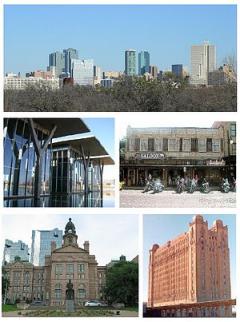

Fort Worth is the sixteenth most populous city in the United States of America and the fifth most populous city in the state of Texas. Located in North Central Texas, the city is a cultural gateway into the American West and covers nearly 300 square miles (780 km2) in Tarrant, Denton, and Wise counties, serving as the seat for Tarrant County. According to the 2010 Census, Fort Worth had a population of 741,206. The city is the second most populous in the Dallas aeFort Worth metropolitan area.
The city was established in 1849 as an Army outpost on a bluff overlooking the Trinity River. Today Fort Worth still embraces its Western heritage and traditional architecture and design. USS Fort Worth (LCS-3) is the first ship of the United States Navy named after the city.
Fort Worth is home to the Kimbell Art Museum, considered to have one of the best collections in the world, and housed in what is widely regarded as the most beautiful work of modern architecture in the world. Also of note are the Museum of Modern Art and the Amon Carter Museum, the latter of which houses one of the most extensive collections of American art in the world, in a building designed by Philip Johnson. The city is also home to Texas Christian University and Texas Wesleyan University and many multinational corporations including Bell Helicopter, Lockheed Martin, and others.
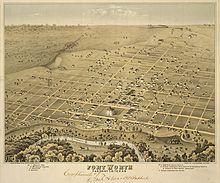
Major General William Jenkins Worth (1794 ae1849) was second in command to General Zachary Taylor at the opening of the Mexican aeAmerican War in 1846. After the war, Worth was placed in command of the Department of Texas in 1849. In January 1849 Worth proposed a line of ten forts to mark the western Texas frontier from Eagle Pass to the confluence of the West Fork and Clear Fork of the Trinity River. One month later Worth died from cholera. General William S. Harney assumed command of the Department of Texas and ordered Major Ripley A. Arnold to find a new fort site near the West Fork and Clear Fork. On June 6, 1849, Arnold established a camp on the bank of the Trinity River and named the post Camp Worth in honor of the late General Worth. In August 1849 Arnold moved the camp to the north-facing bluff which overlooked the mouth of the Clear Fork of the Trinity River.
Although Native American attacks were still a threat in the area, pioneers were already settling near the fort. E. S. Terrell (1812 ae1905) claimed to be the first resident of Fort Worth. The fort was flooded the first year and moved to the top of the bluff where the courthouse sits today. No trace of the original fort remains.

Fort Worth went from a sleepy outpost to a bustling town when it became a stop along the legendary Chisholm Trail, the dusty path on which millions of head of cattle were driven north to market. Fort Worth became the center of the cattle drives, and later, the ranching industry. Its location on the Old Chisholm Trail helped establish Fort Worth as a trading and cattle center and earned it the nickname "Cowtown".
During the 1860s Fort Worth suffered from the effects of the Civil War and Reconstruction. The population dropped as low as 175, as money, food, and supply shortages burdened the residents. Gradually, however, the town began to revive.
By 1872 Jacob Samuels, William Jesse Boaz, and William Henry Davis had opened general stores. The next year Khleber M. Van Zandt established Tidball, Van Zandt, and Company, which became Fort Worth National Bank in 1884.
In 1875, the Dallas Herald published an article by a former Fort Worth lawyer, Robert E. Cowart, who wrote that the decimation of Fort Worth's population, caused by the economic disaster and hard winter of 1873, had dealt a severe blow to the cattle industry. He further stated that the harm to the cattle industry, combined with the railroad stopping the laying of track 30 miles (48 km) outside of Fort Worth, had caused Fort Worth to become such a drowsy place that he saw a panther (cougar, mountain lion) asleep in the street by the courthouse. Although an intended insult, the name Panther City was enthusiastically embraced when in 1876 Fort Worth recovered economically. Many businesses and organizations continue to use Panther in their name. The Fort Worth police have a panther prominently set at the top of their badge.
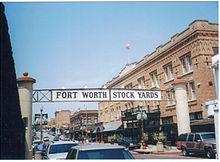
In 1876, the Texas and Pacific Railway arrived in Fort Worth, causing a boom and transforming the Fort Worth Stockyards into a premier cattle industry in wholesale trade. The arrival of the railroad ushered in an era of astonishing growth for Fort Worth, as migrants from the devastated war-torn South continued to swell the population, and small, community factories and mills yielded to larger businesses. Newly dubbed the "Queen City of the Prairies", Fort Worth supplied a regional market via the growing transportation network.
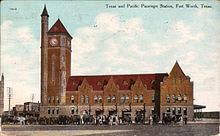
Fort Worth became the westernmost railhead and a transit point for cattle shipment. With the city's main focus being on cattle and the railroads, local businessman, Louville Niles, formed the Fort Worth Stockyards Company in 1893. Shortly thereafter, the two biggest cattle slaughtering firms at the time, Armour and Swift, both established operations in the new stockyards.
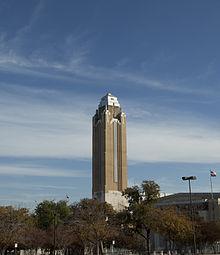
With the boom times came some problems. Fort Worth had a knack for separating cattlemen from their money. Cowboys took full advantage of their last brush with civilization before the long drive on the Chisholm Trail from Fort Worth up north to Kansas. They stocked up on provisions from local merchants, visited the colorful saloons for a bit of gambling and carousing, then galloped northward with their cattle only to whoop it up again on their way back. The town soon became home to Hell's Half Acre, the biggest collection of bars, dance halls and bawdy houses south of Dodge City, Kansas (the northern terminus of the Chisholm Trail), giving Fort Worth the nickname of "The Paris of the Plains".
Crime was rampant, and certain sections of town were off-limits for proper citizens. Shootings, knifings, muggings and brawls became a nightly occurrence. Cowboys were joined by a motley assortment of buffalo hunters, gunmen, adventurers, and crooks. As the importance of Fort Worth as a crossroads and cowtown grew, so did Hell's Half Acre.
What was originally limited to the lower end of Rusk Street (renamed Commerce Street in 1917) spread out in all directions. By 1881 the Fort Worth Democrat was complaining that Hell's Half Acre covered more like 2.5 acres (10,000 m2).
The Acre grew until it sprawled across four of the city's main north-south thoroughfares. These boundaries, which were never formally recognized, represented the maximum area covered by the Acre, around 1900. Occasionally, the Acre was also referred to as "the bloody Third Ward" after it was designated one of the city's three political wards in 1876.
Long before the Acre reached its maximum boundaries, local citizens had become alarmed at the level of crime and violence in their city. In 1876 Timothy Isaiah (Longhair Jim) Courtright was elected City Marshal with a mandate to tame the Acre's wilder activities.
Courtright cracked down on violence and general rowdiness by sometimes putting as many as 30 people in jail on a Saturday night, but allowed the gamblers to operate unmolested. After receiving information that train and stagecoach robbers, such as the Sam Bass gang, were using the Acre as a hideout, local authorities intensified law-enforcement efforts. Yet certain businessmen placed a newspaper advertisement arguing that such legal restrictions in Hell's Half Acre would curtail the legitimate business activities there.
Despite this tolerance from business, however, the cowboys began to stay away, and the businesses began to suffer. City officials muted their stand against vice. Courtright lost support of the Fort Worth Democrat and consequently lost when he ran for reelection in 1879.
Throughout the 1880s and 1890s the Acre continued to attract gunmen, highway robbers, card sharps, con men, and shady ladies, who preyed on out-of-town and local sportsmen.
At one time or another reform-minded mayors like H. S. Broiles and crusading newspaper editors like B. B. Paddock declared war on the district but with no long-term results. The Acre meant income for the city (all of it illegal) and excitement for visitors. This could possibly be why the reputation of the Acre was sometimes exaggerated by raconteurs which longtime Fort Worth residents claimed the place was never as wild as its reputation.
Suicide was responsible for more deaths than murder, and the chief victims were prostitutes, not gunmen. However much its reputation was exaggerated, the real Acre was bad enough. The newspaper claimed "it was a slow night which did not pan out a cutting or shooting scrape among its male denizens or a morphine experiment by some of its frisky females."
The loudest outcries during the periodic clean-up campaigns were against the dance halls, where men and women met, as opposed to the saloons or the gambling parlors, which were virtually all male.
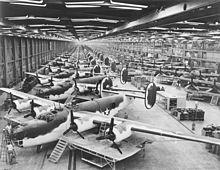
A major reform campaign in the late 1880s was brought on by Mayor Broiles and County Attorney R. L. Carlock after two events. In the first of these, on February 8, 1887, Luke Short and Jim Courtright had a shootout on Main Street that left Courtright dead and Short the "King of Fort Worth Gamblers."
Although the fight did not occur in the Acre, it focused public attention on the city's underworld. A few weeks later, a poor prostitute known only by the name of Sally was found murdered and nailed to an outhouse door in the Acre.
These two events, combined with the first prohibition campaign in Texas, helped to shut down the Acre's worst excesses in 1889. More than any other factor, urban growth began to improve the image of the Acre, as new businesses and homes moved into the south end of town.
Another change was the influx of black residents. Excluded from the business end of town and the nicer residential areas, Fort Worth's black citizens, who numbered some 7,000 out of a total population of 50,000 around 1900, settled into the southern portion of the city. Though some joined in the profitable vice trade (to run, for instance, the Black Elephant Saloon), many others found legitimate work and bought homes.
A third change was in the popularity and profitability of the Acre, which was no longer attracting cowboys and out-of-town visitors. Its visible populace was now more likely to be derelicts and the homeless.
By 1900 most of the dance halls and gamblers were gone. Cheap variety shows and prostitution became the chief forms of entertainment. The Progressive Era was similarly making its reformist mark felt in districts like the Acre all over the country.
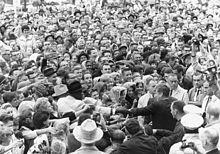
In 1911 Rev. J. Frank Norris launched an offensive against racetrack gambling in the Baptist Standard and used the pulpit of the First Baptist Church to attack vice and prostitution. Norris used the Acre to scourge the leadership of Fort Worth. When he began to link certain Fort Worth businessmen with property in the Acre and announce their names from his pulpit, the battle heated up.
On February 4, 1912, Norris's church was burned to the ground; that evening his enemies tossed a bundle of burning oiled rags onto his porch, but the fire was extinguished and caused minimal damage. A month later the arsonists succeeded in burning down the parsonage.
In a sensational trial lasting a month, Norris was charged with perjury and arson in connection with the two fires. He was acquitted, but his continued attacks on the Acre accomplished little until 1917. A new city administration and the federal government, which was eying Fort Worth as a potential site for a major military training camp, joined forces with the Baptist preacher to bring down the curtain on the Acre finally.
The police department compiled statistics showing that 50% of the violent crime in Fort Worth occurred in the Acre, a shocking confirmation of long-held suspicions. After Camp Bowie was located on the outskirts of Fort Worth in the summer of 1917, martial law was brought to bear against prostitutes and barkeepers of the Acre. Fines and stiff jail sentences curtailed their activities. By the time Norris held a mock funeral parade to "bury John Barleycorn" in 1919, the Acre had become a part of Fort Worth history. The name, nevertheless, continued to be used for three decades thereafter to refer to the depressed lower end of Fort Worth.
On March 28, 2000, at 6:15 pm, an F3 (some estimates claim an F4) tornado smashed through downtown, tearing many buildings into shreds and scrap metal. One of the hardest hit structures was Bank One Tower, which was one of the dominant features of the Fort Worth skyline and which had on its top floor a popular restaurant. It has since been converted to upscale condominiums and officially renamed "The Tower". This was the first major tornado to strike Fort Worth proper since the early 1940s.
When oil began to gush in West Texas in the early 20th century, and again in the late 1970s, Fort Worth was at the center of the wheeling and dealing. In July 2007, advances in horizontal drilling technology made vast natural gas reserves in the Barnett Shale available directly under the city, helping many residents receive royalty checks for their mineral rights. Today the City of Fort Worth and many residents are dealing with the benefits and issues associated with the natural gas reserves under ground.
Fort Worth was the fastest-growing large city in the United States from 2000 to 2006 and was voted one of "America's Most Livable Communities."

Fort Worth is located in North Texas and in the South portion of the United States. Fort Worth is part of the Cross Timbers region; this region is a boundary between the more heavily forested eastern regions and the Great Plains. Specifically, the city is part of the Grand Prairie ecoregion within the Cross Timbers.
The Dallas aeFort Worth metroplex is the hub of the North Texas region. According to the United States Census Bureau, the city has a total area of 298.9 square miles (774 km2), of which 292.5 square miles (758 km2) is land and 6.3 square miles (16 km2) (2.12%) is water.
A large storage dam was built in 1913 on the West Fork of the Trinity River, 7 miles (11 km) from the city, with a storage capacity of 30 billion US gallons (110,000,000 m ³) of water. The lake formed by this dam is known as Lake Worth. The cost of the dam was nearly US$1,500,000 ae a handsome sum at the time.
Fort Worth has a humid subtropical climate according to the Koppen climate classification system. The hottest month of the year is July, when the average high temperature is 95 °F (36 °C), and overnight low temperatures average 72 °F (23 °C), giving an average temperature of 84 °F (29 °C). The coldest month of the year is January, when the average high temperature is 55 °F (13 °C), and low temperatures average 31 °F ( na1 °C). The average temperature in January is 43 °F (6 °C). The highest temperature ever recorded in Fort Worth is 113 °F (45 °C), on June 26, 1980 and June 27, 1980. The coldest temperature ever recorded in Fort Worth is na7 °F ( na22 °C), on December 24, 1989 Because of its position in North Texas, Fort Worth is very susceptible to supercell thunderstorms, which produce large hail and can produce tornadoes. (See recent history above.)
The average annual precipitation for Fort Worth is 34.01 inches (863.8 mm). The wettest month of the year is May, when 4.58 inches (116.3 mm) of precipitation falls. The driest month of the year is January, when only 1.70 inches (43.2 mm) of precipitation falls The average annual snowfall in Fort Worth is 2.6 inches (66.0 mm)
Fort Worth's all-time high temperature was 113 °F (45 °C) on June 26 ae27, 1980 during the Great 1980 Heat Wave, and the all-time low temperature was na8 °F ( na18.3 °C) on February 12, 1899.
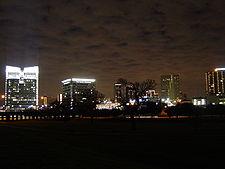
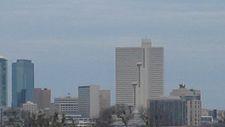
According to the 2006 ae2008 American Community Survey, the racial composition of Fort Worth was as follows:
Source:
As of the census of 2000, there were 534,694 people, 195,078 households, and 127,581 families residing in the city. The July 2004 census estimates have placed Fort Worth in the top 20 most populous cities (# 19) in the U.S. with the population at 604,538. Fort Worth is also in the top 5 cities with the largest numerical increase from July 1, 2003 to July 1, 2004 with 17,872 more people or a 3.1% increase. The population density was 1,827.8 people per square mile (705.7/km ²). There were 211,035 housing units at an average density of 721.4 per square mile (278.5/km ²). The racial makeup of the city was 59.69% White, 20.26% Black or African American, 0.59% Native American, 2.64% Asian, 0.06% Pacific Islander, 14.05% from other races, and 2.72% from two or more races. 29.81% of the population were Hispanic or Latino of any race.
In 1970, the Census Bureau reported Fort Worth's population as 7.9% Hispanic, 19.9% Black, and 72% non-Hispanic White.
There were 195,078 households out of which 34.7% had children under the age of 18 living with them, 45.8% were married couples living together, 14.7% had a female householder with no husband present, and 34.6% are classified as non-families by the United States Census Bureau. Of 195,078 households, 9,599 are unmarried partner households: 8,202 heterosexual, 676 same-sex male, and 721 same-sex female households.
28.6% of all households were made up of individuals and 7.7% had someone living alone who was 65 years of age or older. The average household size was 2.67 and the average family size was 3.33.
In the city the population was spread out with 28.3% under the age of 18, 11.3% from 18 to 24, 32.7% from 25 to 44, 18.2% from 45 to 64, and 9.6% who were 65 years of age or older. The median age was 31 years. For every 100 females there were 97.3 males. For every 100 females age 18 and over, there were 94.5 males.
The median income for a household in the city was $37,074, and the median income for a family was $42,939. Males had a median income of $31,663 versus $25,917 for females. The per capita income for the city was $18,800. About 12.7% of families and 15.9% of the population were below the poverty line, including 21.4% of those under age 18 and 11.7% of those age 65 or over.
Fort Worth stands as the ninth-safest U.S. city among those with a population over 500,000 in 2006.
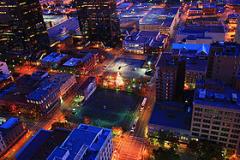
Downtown is mainly known for its Art Deco-style buildings. The Tarrant County Courthouse was created in the American Beaux Arts design, which was modeled after the Texas State Capitol building. Most of the structures about Sundance Square have preserved their early 20th-century facades.
The city of Fort Worth contains over 1000 natural gas wells (December 2009 count) tapping the Barnett Shale. Each well site is a bare patch of gravel 2 ae5 acres (8,100 ae20,000 m2) in size. As city ordinances permit them in all zoning categories, including residential, well sites can be found in a variety of locations. Some wells are surrounded by masonry fences but most are secured by chain link.
Building on its western heritage and a history of strong local arts patronage, Fort Worth has, in recent years, begun promoting itself as the "City of Cowboys and Culture."
Bass Performance Hall, Casa MaR±ana, Stage West Theatre, Kids Who Care Inc., Jubilee Theater, Circle Theatre
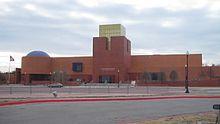
Kimbell Art Museum, Amon Carter Museum of American Art, Modern Art Museum of Fort Worth, Sid Richardson Museum, Fort Worth Museum of Science and History, National Cowgirl Museum and Hall of Fame, Military Museum of Fort Worth, Texas Civil War Museum, Texas Cowboy Hall of Fame, Fort Worth Stockyards Museum
Fort Worth Symphony Orchestra, Billy Bob's, Texas Ballet Theater, Van Cliburn International Piano Competition (Bass Hall), Fort Worth Opera (Scott Theater), Live Eclectic Music (Ridglea Theater)
The Academy of Western Artists, based in Gene Autry, Oklahoma presents its annual awards in Fort Worth in fields related to the American cowboy, including music, literature, and even chuckwagon cooking.
The Fort Worth Zoo is home to over 5000 animals and has been named as a top zoo in the nation by Family Life magazine, the Los Angeles Times and USA Today and one of the top zoos in the South by Southern Living Reader's Choice Awards; it has been ranked in the top 10 zoos in the United States.
The Fort Worth Botanic Garden and the Botanical Research Institute of Texas are also in the city. For those interested in hiking, birding and canoeing The Fort Worth Nature Center & Refuge in northwest Fort Worth is a 3621 acre preserved natural area designated by the Department of the Interior as a National Natural Landmark Site in 1980. Established in 1964 as the Greer Island Nature Center & Refuge, the FWNC&R will celebrate its 50th Anniversary in 2014. The Nature Center has small genetically pure bison herd, a resident prairie dog town and prairie upon which they live. It is one of the largest urban parks of its type in the US.
While much of Fort Worth's sports attention is focused on the Metroplex's professional sports teams, the city has its own athletic identity. The TCU Horned Frogs compete in NCAA Division I Athletics, including the football team that is consistently ranked in the Top 25, and the baseball team has competed in the last six NCAA Tournaments and came within a win of making the College World Series in 2009. The women's basketball team has competed in the last seven NCAA Tournaments. Texas Wesleyan University competes in the NAIA, and were the 2006 NAIA Div. I Men's Basketball champions and three-time National Collegiate Table Tennis Association (NCTTA) team champions (2004 ae2006). Fort Worth is also home to the NCAA football Bell Helicopter Armed Forces Bowl as well as four minor-league professional sports teams. One of these minor league teams, the Fort Worth Cats baseball team, were reborn in 2001. The original Cats were a very popular minor league team in Fort Worth from the 19th century (when they were called the Panthers) until 1960, when the team was merged into the Dallas Rangers.
The presence of Texas Christian University less than 5 miles (8 km) from downtown and national competitiveness in football, baseball, and men's and women's basketball have sustained TCU as an important part of Fort Worth's sports scene.
The Horned Frog football team produced two national championships in the 1930s and remained a strong competitor in the Southwest Conference into the 1960s before beginning a long period of underperformance. The revival of the TCU football program began under Coach Dennis Franchione with the success of running back LaDainian Tomlinson. Under Head Coach Gary Patterson, the Horned Frogs have developed into a perennial Top-10 contender, and a Rose Bowl winner in 2011. Notable players include Sammy Baugh, Davey O'Brien, Bob Lilly, LaDainian Tomlinson, Jerry Hughes, and Andy Dalton. The Horned Frogs, along with their rivals and fellow non-AQ leaders the Boise State Broncos were deemed the quintessential "BCS Busters", having appeared in both the Fiesta and Rose Bowls. Their "BCS Buster" role ended in 2012 when they joined the Big 12 athletic conference in all sports. The Horned Frog football teams have one of the best winning percentages of any school in the Football Bowl Subdivision in recent years.
Fort Worth hosts one of the most important professional men's golf tournaments every May at the Colonial Country Club. The Colonial Invitational Golf Tournament, now officially known as Crowne Plaza Invitational at Colonial, is one of the most prestigious and historical events of the Tour calendar. The Colonial Country Club was the home course of golfing legend Ben Hogan, who was from Fort Worth. The Crowne Plaza Invitational at Colonial is considered by the PGA and PGA Tour Professionals as the "Fifth Major".
Ft. Worth has the Texas Motor Speedway (also known as "The Great American Speedway"), a NASCAR track located in the far north part of the city in Denton County. Also, the IndyCar Series has raced here since 1997 in a race called the Bombardier Learjet 550.
Amateur sports car racing in the greater Fort Worth area occurs mostly at two purpose-built tracks: Motorsport Ranch and Eagles Canyon Raceway. Sanctioning bodies include the Porsche Club of America, the National Auto Sports Association (NASA) and the Sports Car Club of America (SCCA).
Major companies based in Fort Worth include AMR (and subsidiaries American Airlines and American Eagle Airlines), the John Peter Smith Hospital, Pier 1 Imports, RadioShack, the BNSF Railway, FUNimation Entertainment, Gallus Cycles, and Lockheed Martin.
Fort Worth shares its media market with the city of Dallas.
The cities magazine is Fort Worth, Texas Magazine - FWTX.com. FWTX.com has a wealth of information about happenings in Fort Worth.
There are many radio stations in and around Fort Worth, with many different formats.
On the AM dial, like in all other markets, political talk radio is prevalent, with WBAP 820, KLIF 570, KSKY 660, KRLD 1080, KVCE 1160 the conservative talk stations serving Fort Worth and KMNY 1360 the sole progressive talk station serving the city. KFXR 1190 is a news/talk/classic country station. Sports talk can be found on KTCK 1310 ("The Ticket"). WBAP, a 50,000-watt clear-channel station which can be heard over much of the country at night, was a long-successful country music station before converting to its current talk format.
There are also several religious stations on AM in the Dallas/Fort Worth area; KHVN 970 and KGGR 1040 are the local urban gospel stations and KKGM 1630 has a Southern gospel format.
Fort Worth's Spanish-speaking population is served by many stations on AM:
There are also a few mixed Asian language stations serving Fort Worth:
Other formats found on the Fort Worth AM dial are Radio Disney KMKI 620, urban KKDA 730, business talk KJSA 1120, country station KCLE 1460.
Non-commercial stations serve the city fairly well. There are three college stations that can be heard--KTCU 88.7, KCBI 90.9, and KNTU 88.1, with a variety of programming. There is also local NPR station KERA 90.1, along with community radio station KNON 89.3. Downtown Fort Worth also hosts the Texas Country radio station KFWR 95.9 The Ranch.
A wide variety of commercial formats, mostly music, are on the FM dial in Fort Worth, also.
When local radio station KOAI 107.5 FM, now KMVK, dropped its smooth jazz format, fans set up smoothjazz1075.com, an internet radio station, to broadcast smooth jazz for disgruntled fans.
There are a couple of internet radio shows in the Fort Worth area, like DFDubbIsHot and The Broadband Brothers.
Fort Worth has one newspaper published daily, the Fort Worth Star-Telegram. The Star-Telegram is the forty-fifth most widely circulated newspaper in the United States, with a daily circulation of 210,990 and a Sunday circulation of 304,200.
The Fort Worth Weekly is an alternative weekly newspaper that serves the Dallas/Fort Worth Metroplex. The newspaper has an approximate circulation of 50,000. The Fort Worth Weekly publishes every Wednesday and features, among many things, news reporting, cultural event guides, movie reviews, and editorials.
Fort Worth Business Press is a weekly publication that chronicles news in the Fort Worth business community. Fort Worth, Texas magazine is a monthly publication that highlights the social and cultural life of the city.
The Fort Worth Press was a daily newspaper, published weekday afternoons and on Saturdays from 1900 until 1975. It was owned by the E. W. Scripps Company and published under the then-prominent Scripps-Howard Lighthouse logo. The paper reportedly last made money in the early 1950s. Scripps Howard stayed with the paper until mid 1975. Circulation had dwindled to fewer than 30,000 daily, just more than 10% of that of the Fort Worth Star Telegram. The name Fort Worth Press was resurrected briefly in a new Fort Worth Press paper operated by then-former publisher Bill McAda and briefer still by William Dean Singleton, then-owner of the weekly Azle (Texas) News, now owner of the Media Central news group. The Fort Worth Press operated from offices and presses at 500 Jones street in downtown Fort Worth.
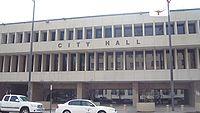
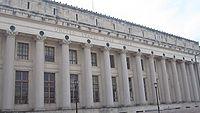
The Texas Department of Transportation operates the Fort Worth District Office in Fort Worth.
The North Texas Intermediate Sanction Facility, a privately operated prison facility housing short-term parole violators, was in Fort Worth. It was operated on behalf of the Texas Department of Criminal Justice. In 2011 the state of Texas decided not to renew its contract with the facility.
Fort Worth is split between Texas' 12th congressional district, represented by Republican Kay Granger, and Texas' 26th congressional district, represented by Republican Michael Burgess.
Fort Worth is home to one of the two locations of the Bureau of Engraving and Printing. In 1987, construction on this second facility began. In addition to meeting increased production requirements, a western location was seen to serve as a contingency operation in case of emergencies in the Washington, D.C. metropolitan area; as well, costs for transporting currency to Federal Reserve banks in San Francisco, Dallas, and Kansas City would be reduced. Currency production began in December 1990 at the Fort Worth facility, with the official dedication taking place April 26, 1991.
Federal Medical Center, Carswell, a federal prison and health facility for women, is located in the Naval Air Station Joint Reserve Base Fort Worth. Carswell houses the two female federal death row inmates.
Like most cities that grew heavily after World War II, Fort Worth's main mode of transportation is the automobile. But Fort Worth offers bus transportation via The T, as well as an interurban train service to Dallas via the Trinity Railway Express.
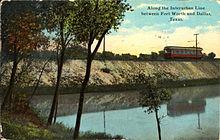
The first streetcar company in Fort Worth was the Fort Worth Street Railway Company. Its first line began operating in December 1876, and traveled from the courthouse down Main Street to the T&P Depot. By 1890, there were more than 20 private companies operating streetcar lines in Fort Worth. The Fort Worth Street Railway Company bought out many of its competitors, and was eventually itself bought out by the Bishop & Sherwin Syndicate in 1901. The new ownership changed the company's name to the Northern Texas Traction Company. The Northern Texas Traction Company operated 84 miles of streetcar railways in 1925, and their lines connected downtown Fort Worth to TCU, the Near Southside, Arlington Heights, Lake Como, and the Stockyards.
At its peak, the electric interurban industry in Texas, consisted of almost 500 miles of track, making Texas the second in interurban mileage in all states west of the Mississippi River. Electric interurban railways were prominent in the early 1900s, peaking in the 1910s and fading until all electric interurban railways were abandoned by 1948. Close to three-fourths of the mileage was in the Dallas-Fort Worth Area, running between Fort Worth and Dallas and to other area cities including Cleburne, Denison, Corsicana and Waco. The depicted in the associated image was the second to be constructed in the State of Texas and ran thirty-five miles between Fort Worth and Dallas. Northern Texas Traction Company built the railway, which was operational from 1902 to 1934.
Fort Worth is served by four Interstates and two US highways. It also contains a number of arterial streets in a grid formation.
Interstate highways 30, 20, 35W, and 820 all pass through the city limits.
Interstate 820 is a spur of Interstate 20 and serves as a beltway for the city. Interstate 30 and Interstate 20 connect Fort Worth to Arlington, Grand Prairie, and Dallas. Interstate 35W connects Fort Worth with Hillsboro to the south and the cities of Denton and Gainesville to the north.
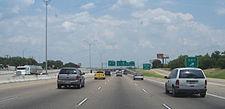
U.S. Route 287 runs southeast through the city connecting Wichita Falls to the north and Mansfield to the south. U.S. Route 377 runs south through the northern suburbs of Haltom City and Keller through the central business district.
Notable state highways are:
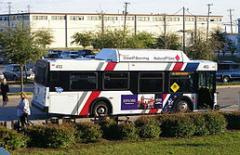
A 2011 study by Walk Score ranked Fort Worth 47th most walkable of fifty largest U.S. cities.
Fort Worth Library is the public library system.
Most of Fort Worth is served by the Fort Worth Independent School District.
Other school districts that serve portions of Fort Worth include:
The portion of Fort Worth within the Arlington Independent School District contains a wastewater plant. No residential areas are in the portion.
Pinnacle Academy of the Arts (K-12) is a state charter school.
St. Rita Catholic School (PreK-8)
The Roman Catholic Diocese of Fort Worth oversees several Catholic elementary and middle schools.
Fort Worth is a part of the Sister Cities International program and maintains cultural and economic exchange programs with its eight sister cities.


Word Count: 6335






